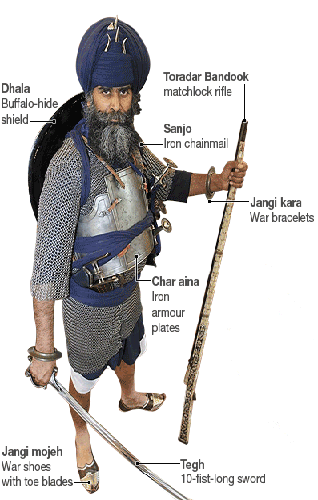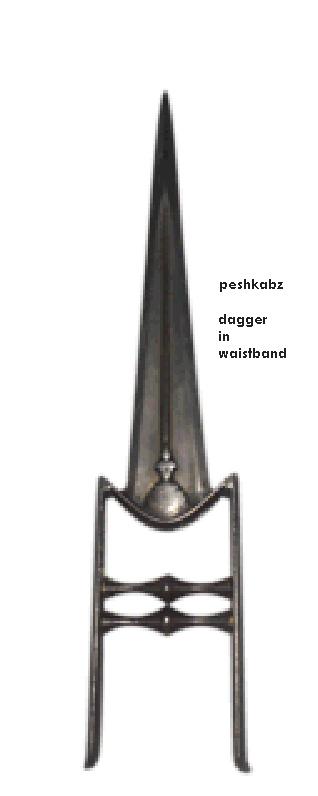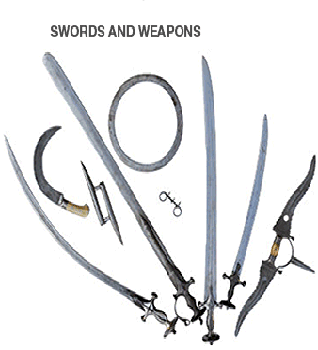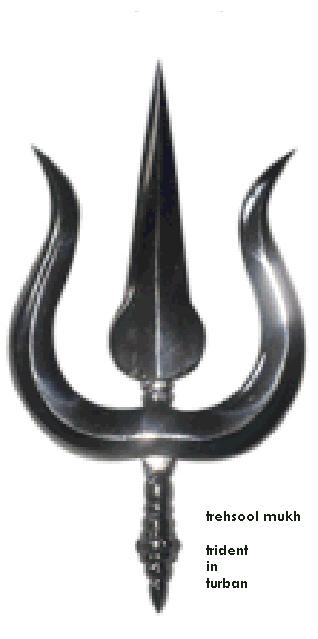Art
Staying Alive:
An Old School of Sikh Martial Arts
by STEPHANIE HEGARTY
A former factory worker from the British Midlands, U.K., may be the last of the known practitioners of the centuries-old Sikh battlefield art of shastar vidya. The father of four is now engaged in a full-time search for a successor who will carry on the tradition..
The basis of shastar vidya, the "science of weapons" is a five-step movement: advance on the opponent, hit his flank, deflect incoming blows, take a commanding position and strike.
It was developed by Sikhs in the 17th Century as the young world religion came under attack from hostile Muslim and Hindu neighbours, and has been known to a dwindling band since the British forced Sikhs to give up arms in the 19th Century.
Nidar Singh, a 44-year-old former food packer from Wolverhampton, is now thought to be the only remaining practitioner. He has many students, but shastar vidya takes years to learn and a commitment in time and energy that doesn't suit modern lifestyles.
"I've travelled all over India and I have spoken to many elders, this is basically a last-ditch attempt to flush someone out because if I die with it, it is all gone."
He would be overjoyed to discover another existing practitioner, or to find a talented young student determined to dedicate his life to the art.Until he was 17 years old, he knew little of his Sikh heritage. His family were not religious - he wore his hair short and dressed like any non-Sikh British teenager. He was a keen wrestler, but knew nothing of martial arts.
He spent his childhood between Punjab and Wolverhampton and it was on one of these trips to see an aunt in Punjab that he met Baba Mohinder Singh, the old man who was to become his mentor.
Already in his early 80s, Baba Mohinder Singh had abandoned life as a hermit in a final effort to find someone to pass on his knowledge to.
"When he saw my physique he looked at me, even though I was clean-shaven and he asked me: 'Do you want to learn how to fight'," recalls Nidar Singh. "I couldn't say no."
On his first day of training, the frail old man handed him a stick and instructed Nidar to hit him. When he tried, the teacher threw him around like a rag doll.
"He was a frail old man chucking me about and I couldn't touch him," he says. "That definitely impressed me."
Open-minded
Nidar Singh spent the next 11 years on his aunt's farm, milking the buffalos in the morning and spending every day training with his mentor.
In 1995 he returned to Britain to get married and took work packing food in a factory. He began to teach shastar vidya and immersed himself in research on early Sikh military history.
Soon he had enough interest from students to go into teaching full-time. He now travels around the United Kingdom to teach classes and to Canada and Germany where eager students have asked him to share his knowledge.
"The people who are here are open-minded," he says. "I have Muslims and Christians here as well as Sikhs."
But even his most advanced pupils have only recently reached the stage where they can fight him with weapons without getting hurt.
Shastar vidya often gets confused with gatka, a fighting technique that was developed during British occupation of Punjab and was widely practised among Sikh soldiers in the British army.
Though it is a highly skilled art, it was developed for exhibition rather than mortal combat. It is much easier to practise in public.
By working to revive a culture and practice that left the mainstream more than 200 years ago, Nidar Singh has come up against a lot of resistance from within the community.
He says he received many threats and admonishments in his first two years as a teacher, from other Sikh groups who disagree with the ideology of shastar vidya and the beliefs of the small Nihang sect, which he identifies with.
"It is not just martial technique, there is a lot of oral tradition and linguistic skills that has to be there as well," he explains.
Some Nihangs still maintain some tenets which are unacceptable in Sikhism, which include reliance on some texts which are anathema to the Sikh faith.
[Nihangs constitute an outdated and virtually defunct remnant of an elite military group employed by Sikh armies until mid-nineteentrh century, but still retain centuries-old mores, garb, language and idiosyncracies today, while existing on the fringe of mainstream Sikh society.]
Some Nihangs also drink alcohol which is prohibited in Sikhism. Traditionally they also drank bhang, an infusion of cannabis [to deal with the rigours of a military life.]
"Sikhism has gone through several stages of evolution," says Christopher Shackle, a former professor of South Asian studies at Soas, University of London. "When the Nihangs were formed at the end of the 17th Century they were a very powerful group but they became rather marginalised."
When the Sikhs established their own kingdom under Maharaja Ranjit Singh, he realised he needed a modern army to keep the British out, and he hired ex-Napoleonic officers to train up his soldiers, sidelining the Nihangs.
The Nihangs were further isolated when the British Raj defeated the Sikh state in 1849 and forced Sikhs to give up arms.
"The British introduced a shoot-to-kill policy," says weapons collector and historian Davinder Singh Tool, adding that accounts of British army officers show some troops fired on any man with a blue turban and a firearm.
"There is a sense that the Nihangs got left behind by time," says Mr Shackle.
Nidar Singh spends a lot of time travelling to India and Pakistan researching the art, searching for descendents of the Akali Nihang and adding to his vast collection of weapons.
So far he has only met four people who could claim to be teachers, now all dead. The last of these, Ram Singh, whom he met in 1998, died four years later.
"Nidar Singh is like someone who has walked straight out of the 18th Century," says Parmjit Singh, who has worked on several books on Nihang culture with the instructor.
"He is like a window into the past."
He is also still hoping to be a door to the future, opening up the path for new practitioners of the art to follow.
[Courtesy: BBC. Edited for sikhchic.com]
October 31, 2011
Conversation about this article
1: Sangat Singh (Kuala Lumpur, Malaysia), October 31, 2011, 8:55 AM.
To see the 'Akali' and his arsenal is enough to strike holy terror. Reminds me of Guru Gobind Singh's famous "jaba ban lago tabay ros jag-a-o" in the Bhangani battle when Guru Sahib playfully made his offer to the opposing Raja who was known for his marksmanship: the Guru gave him 3 free shots. Two missed the target completely, the third arrow just knicked Guru Sahib's belt and produced a drop of blood. It woke his holy 'ros' and said, "Now, get thee ready!" with just one arrow, Guru Sahib brought the tyrant down.
2: T. Sher Singh (Mount Forest, Ontario, Canada), October 31, 2011, 8:55 AM.
A few years ago, while starting the Spinning Wheel Sikh Film Festival movement, I got involved in choreographing a troupe of Bhangra dancers who, for a while, dazzled our audiences under the title of "Young (T)Urban Professionals". What made them unique and a powerful sight to behold was their opening act - they'd suddenly appear amidst an audience in their bhangra moves, wearing dark pin-striped suits and ties, with regular turbans and fully-dressed beards! It charged up the crowd like very few things I have seen do ... and little kids lined up in droves in the weeks, months and years to follow, to learn Bhangra from them. Let me throw out to you a wild idea! If Nidar Singh could, at times, appear before mainstrean Sikh and non-Sikh audiences wearing a formal, western business suit, tie and shoes - while wearing his dastaar and beard as is - I believe he'd attract more of a following and appreciation. I am afraid the persona he is cultivating currently is merely going to make him a ten-day wonder - which is precisely the problem he seems to be underlining in his pleas!
3: Sandeep Singh Brar (Canada), October 31, 2011, 12:15 PM.
I think the issue with Nidar Singh is more complex than just the way he dresses. Rather than present shastar vidya as a martial artist, Nidar has instead created a whole new religious belief system which is completely immersed in Hinduism, and that he promotes. Although Nihang beliefs and practices are unique and quite different in some aspects from mainstream Sikhism, Nidar's religious beliefs are considered even more extreme, to the point that he has even been shunned and rejected by the major Nihang groups. He redefines the 5K's and completely rejects the unity of the Panth achieved through the Singh Sabha movement and instead advocates a return to a time when some Sikhs performed Hindu religious rituals and Hindu idols were present at the mahant controlled Darbar Sahib and other gurdwaras liberated in the Gurdwara Reform Movement of the 1920s. The Panth has evolved and moved on from that time, cleaning house in the process and that kind of devolution of beliefs and practices would only make us weaker, not stronger. The collective history and decisions of the Panth over the last century and a half cannot be arbitrarily dismissed as 'mere products of British influence'. It's a real shame, because Nidar seems to be an accomplished martial artist and knowledgeable historian who has published an excellent book on Hazur Sahib as well as been involved in the recent much acclaimed U.K. exhibit on Darbar Sahib.
4: H.S. Vachoa (U.S.A.), October 31, 2011, 12:16 PM.
I concur with T. Sher Singh. Nidar has been unable to sell the idea even to Sikhs themselves.
5: Amandeep Singh (Leicester, United Kingdom), October 31, 2011, 3:23 PM.
We in the Unite Kingdom know this guy very well. Unfortunately, he has ulterior motives. He wows young and impressionable Sikh youths with his the macho attraction of his amazing martial arts skills and then creates followers for his pseudo-ideology. And preaches that Sikhs are a sect of Hinduism!
6: Baldev Singh (Bradford, United Kingdom), October 31, 2011, 4:54 PM.
The danger is always with brahminism creeping in and bringing with it the 'ME' culture.
7: Taran (London, United Kingdom), October 31, 2011, 5:16 PM.
Don't know Nidar Singh personally. It's great if he is keeping the ancient art and passing on skills to the youngsters.
8: Ajit Singh Batra (Pennsville, New Jersey, U.S.A..), October 31, 2011, 9:56 PM.
The challenge is in connecting the Sikh symbolism around the kirpan with spirituality, if we are to get the youth interested in such traditions. The concept of Sant-Sipahi, the idea of force being only the "last resort", and how Sikh pacifism is tied into the Sikh duty to fight the good fight - all of these have to be imparted properly to the younger generations so that they fully understand them. Bhai Gurdas (Vaar 1,Pauri 48): "Guru Arjan kaa-yaa palat kar moorat Har Gobind swaaree". That is, "The same Guru Arjan had changed his body to become Guru Hargobind". This is how Miri-Piri was introduced in Sikhi.
9: Dilpreet (United Kingdom), November 01, 2011, 12:30 AM.
He is infecting Sikh youth in the United Kingdom. I urge people not to buy into what he preaches - hatred against mainstream Sikhi and a version of our history and heritage that sits too comfortably with the RSS and anti-Sikh groups. Also, keep an eye on his closest supporters - Parmjit Singh and Amandeep Madra who 'research' and make his ideology look legit.
10: Parvin Singh (Santa Clara, California, U.S.A.), November 01, 2011, 12:15 PM.
It's surprising that the guy has toured the entire of South East Asia, and he could not find a single person to whom he could pass over the 'legacy'. It's baffling, because this is how he claims to be the only guy in the world to know the art. Its sheer egotism. And just a way to make another cult out of all this.
11: Frank Levin (U.S.A.), November 12, 2011, 12:39 PM.
He is NOT the only surviving Master! Read Nidar Singh's owns words: KG: Are there many masters of this art? NS: As guns became more popular the emphasis on this art decreased in the itinerant Akali Nihang armies. Today there are not many masters of this art alive. The ones I know, if still alive, are Nihang Baba Ram Singh in U.P., India and Bhai Ranjit Singh of Patiala who has partial knowledge of this art. There are no doubt others in the Buddha Dal (oldest Sikh martial order established in 1606) but they being itinerant mendicants of a secretive nature, are not easy to track down. [Frank Levin, Martials Arts Magazine, U.S.A.]
12: Inderjit Singh (United Kingdom), November 15, 2011, 5:24 PM.
I remember the old days when a Sikh would appear on TV or in a newspaper and we would jump out of our seats and scream out to the family, 'Singh, Singh, quick come here!' But over the past so many years, Sikhs are quite often in the papers and on the TV, at least in the U.K. they are, and the family reaction is just not the same of rushing round the TV. But when I saw this chap, Nidar Singh Nihang - wow! I shouting out to the family, "Tthere is a Singh on BBC!' Only this time, we were gathered around a computer rather than a TV screen. Nidar Singh Nihang has propelled himself to the forefront of media all over the world. His art seems very interesting, and since reading the article I have enjoyed what Nidar has to offer and even ordered his book! Keep up the good work, Nidar, and thanks sikhchic.com for posting this up.
13: Lak (United Kingdom), December 01, 2014, 11:28 PM.
Nidar Singh is not a proper Sikh. He practices a blend of Sikhi and Hinduism which is wrong. He is basically trying to create a new sect of Sikhs and a cult following. He cannot be trusted one bit.






